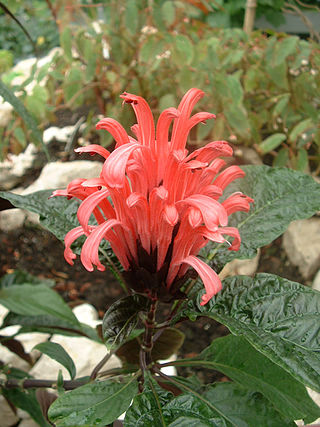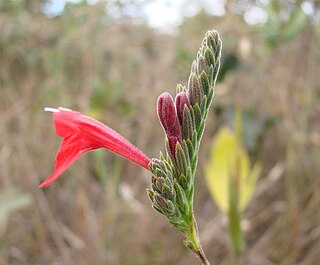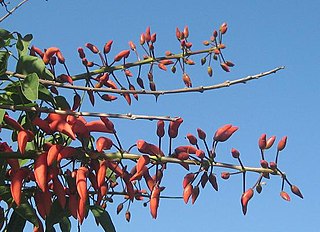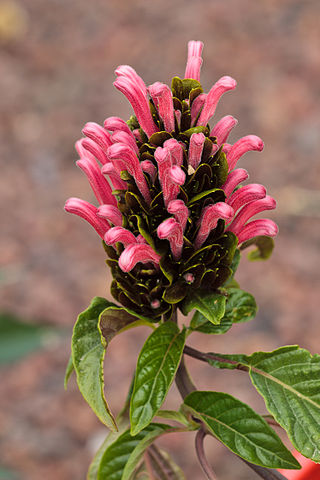
Tropical and subtropical moist broadleaf forests (TSMF), also known as tropical moist forest, is a subtropical and tropical forest habitat type defined by the World Wide Fund for Nature.

The Tijuca National Park is an urban national park in the mountains of the city of Rio de Janeiro, Brazil. The park is part of the Atlantic Forest Biosphere Preserve, and is administered by the Chico Mendes Institute for Biodiversity Conservation (ICMBio).

The Atlantic Forest is a South American forest that extends along the Atlantic coast of Brazil from Rio Grande do Norte state in the northeast to Rio Grande do Sul state in the south and inland as far as Paraguay and the Misiones Province of Argentina, where the region is known as Selva Misionera.

Justicia is a genus of flowering plants in the family Acanthaceae. It is the largest genus within the family, encompassing around 700 species with hundreds more as yet unresolved. They are native to tropical to warm temperate regions of the Americas, India, and Africa. The genus serves as host to many butterfly species, such as Anartia fatima. Common names include water-willow and shrimp plant, the latter from the inflorescences, which resemble a shrimp in some species. The generic name honours Scottish horticulturist James Justice (1698–1763). They are closely related to Pachystachys.

The Cerrado is a vast ecoregion of tropical savanna in eastern Brazil, being present in the states of Goiás, Mato Grosso do Sul, Mato Grosso, Tocantins, Maranhão, Piauí, Bahia, Minas Gerais, São Paulo, Paraná and the Federal District. The core areas of the Cerrado biome are the Brazilian highlands – the Planalto. The main habitat types of the Cerrado consist of forest savanna, wooded savanna, park savanna and gramineous-woody savanna. The Cerrado also includes savanna wetlands and gallery forests.

The Atlantic Coast restingas is an ecoregion of the tropical and subtropical moist broadleaf forests biome, and the South American Atlantic Forest biome. It is located along Brazil's Atlantic coast, from the country's northeast to its southeast.
Justicia burchellii is an ornamental plant native of Cerrado vegetation of Brazil.
Justicia chrysotrichoma is a plant native to the Cerrado vegetation of Brazil. It is one of the species of flowering plants in the family Acanthaceae.

Justicia lanstyakii is a plant native to the Cerrado vegetation of Brazil, first described by Rizzini in 1946.
Justicia angustifolia is a plant native to the Atlantic Forest vegetation of Brazil.
Justicia clausseniana is a flowering perennial plant in the family Acanthaceae. It is native to the Atlantic Forest ecoregions of eastern Brazil.

Aechmea pineliana is a flowering plant in the family Bromeliaceae. It is typical of Atlantic Forest vegetation in Brazil, specially in following states: Espírito Santo, Minas Gerais, and Rio de Janeiro. This plant is cited in Flora Brasiliensis by Carl Friedrich Philipp von Martius, and it is often used as an ornamental plant.

Erythrina falcata, commonly known as the Brazilian coral tree, is a timber tree native to Atlantic Forest vegetation in Brazil, Paraguay and Argentina. This plant is also used as a medicinal plant and ornamental plant which is attractive to birds.

Restingas are a distinct type of coastal tropical and subtropical moist broadleaf forest in eastern Brazil. They form on sandy, acidic, and nutrient-poor soils, and are characterized by medium-sized trees and shrubs adapted to the drier and nutrient-poor conditions. One of the most notable restingas is the Restinga da Marambaia, which is owned and kept by the Brazilian Army.

The Caatinga enclaves moist forests is an ecoregion of the Tropical moist forests Biome, and the South American Atlantic Forest biome. It is located in northeastern Brazil.

The Pernambuco coastal forests is an ecoregion of the Tropical moist broadleaf forests Biome, and the South American Atlantic Forest biome. It is located in northeastern Brazil.
Alchornea triplinervia is a commercial timber tree native to Amazon Rainforest, Atlantic Forest, and Cerrado vegetation in Brazil. This plant is found in the following states of Brazil: Amazonas, Bahia, Espírito Santo, Goiás, Mato Grosso, Mato Grosso do Sul, Minas Gerais, Paraná, Rio de Janeiro, Rio Grande do Sul, Rondônia, Roraima, Santa Catarina, and São Paulo. It is also used as a honey plant.

Justicia carnea, the Brazilian plume flower, Brazilian-plume, flamingo flower, or jacobinia, is a flowering plant in the family Acanthaceae.












